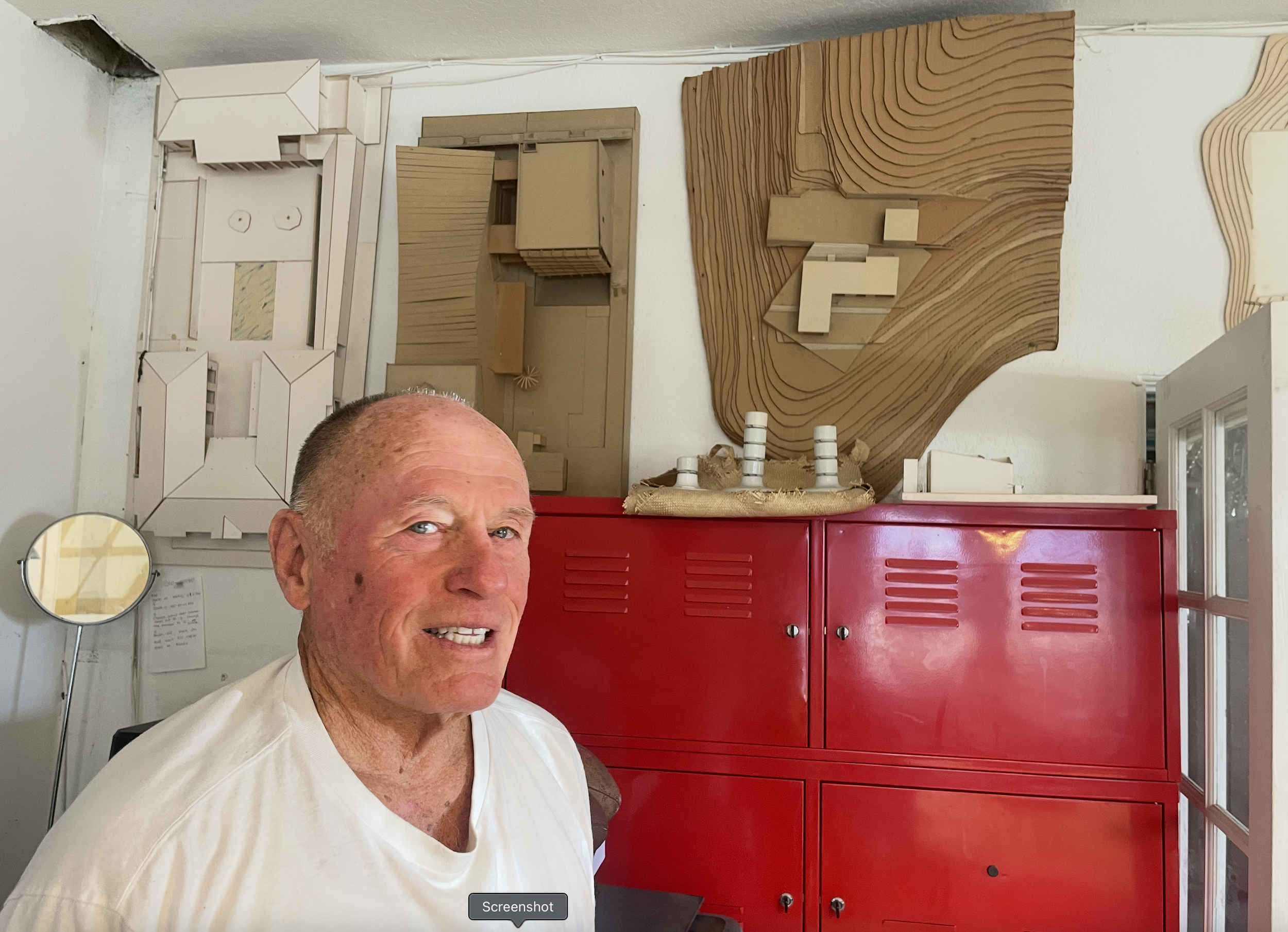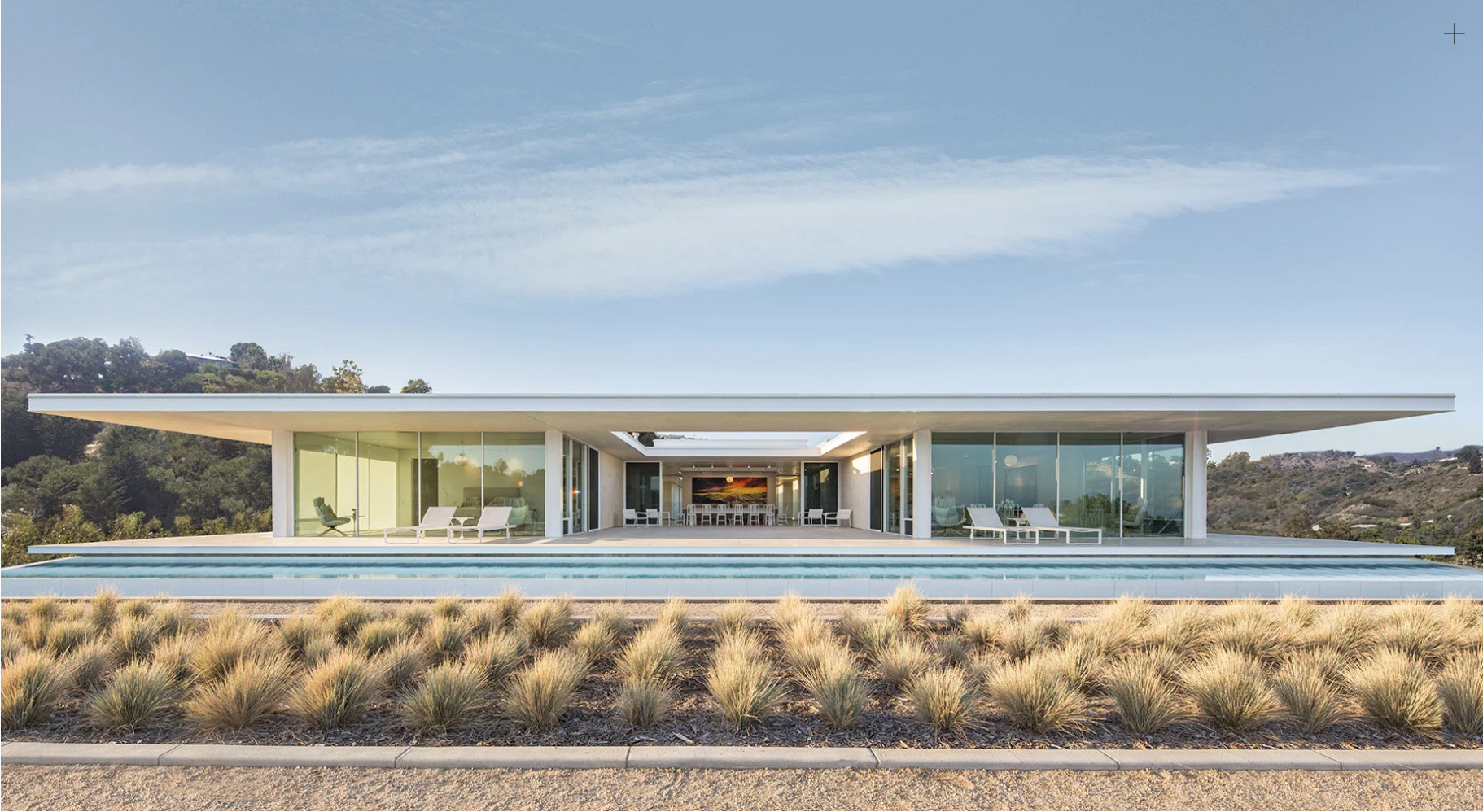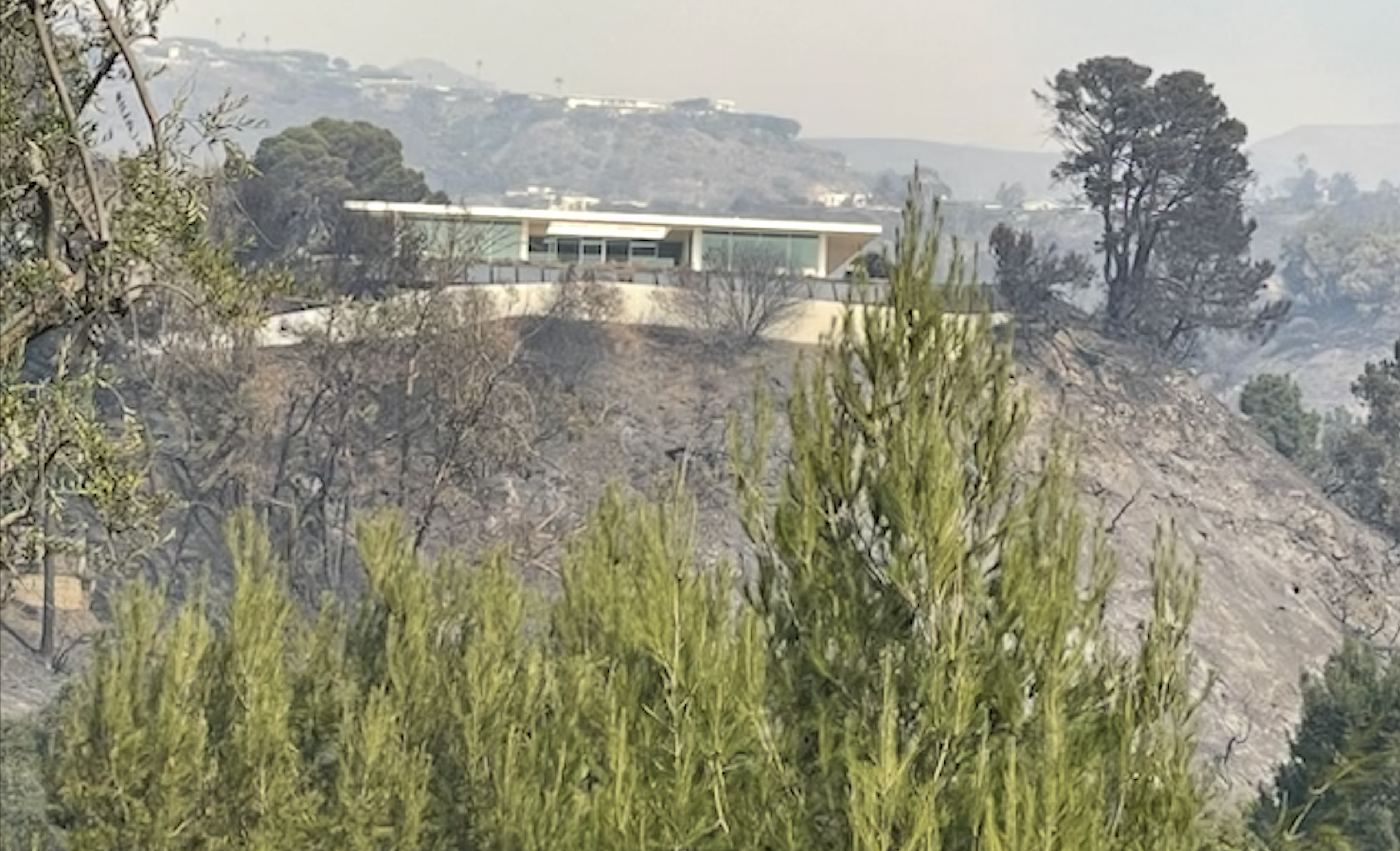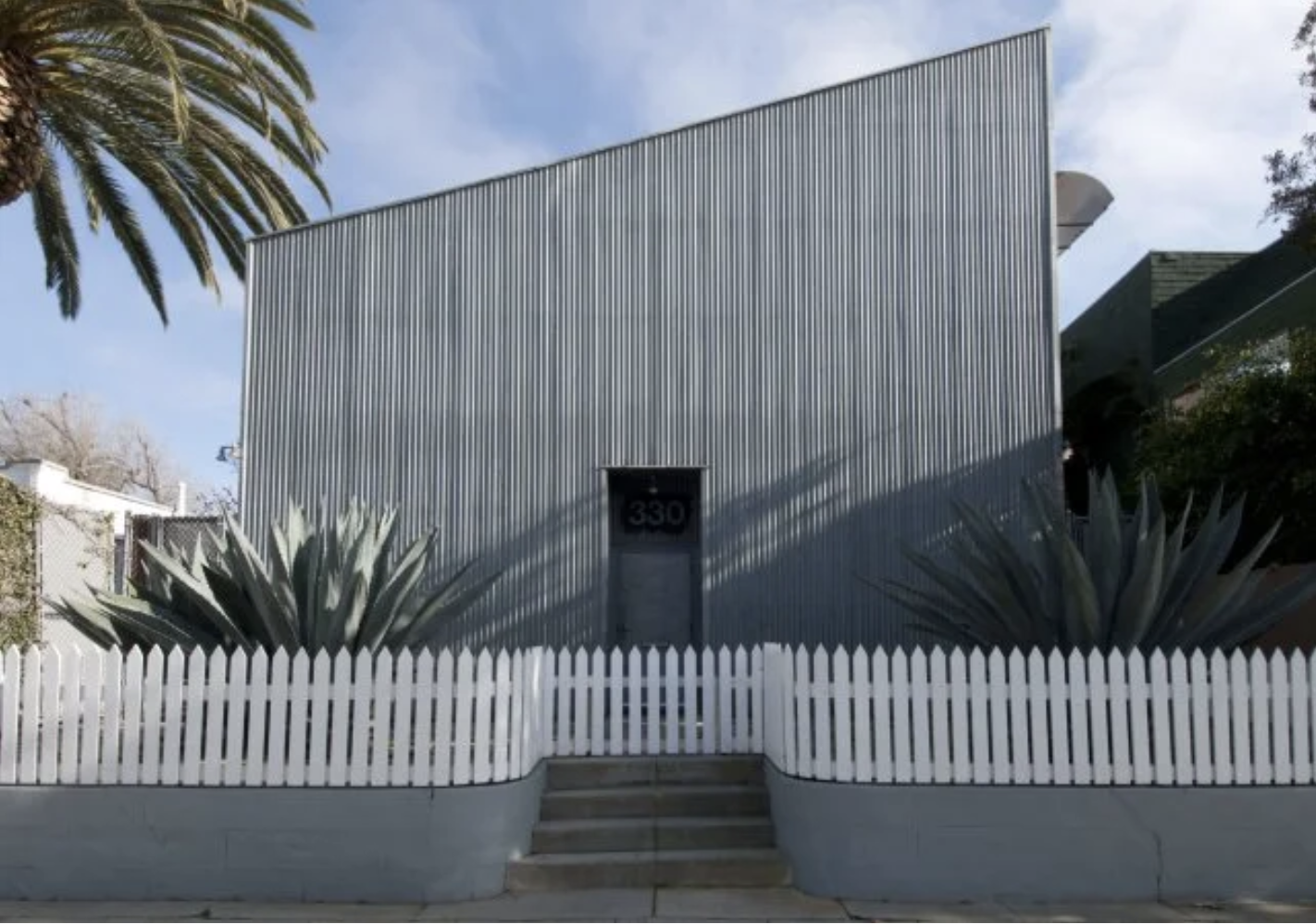Brian Murphy, An Architectural Original in the Canyon
Architect and builder Brian Murphy at his office in front of some of the models for his houses.
By Laurel Busby
News & Information Editor
Atop a mesa visible from the Self-Realization Fellowship sits a house that was ringed in scorched earth after the Palisades Fire.
Brian Murphy’s Mies van der Rohe-inspired home before and after (below) the Palisades Fire.
Designed by Canyon contractor/architect Brian Murphy, the house was one of the few survivors in its devastated neighborhood. Based on the mid-century modernist work of Ludwig Mies van der Rohe and created with fire in mind, the house has a 9-foot cantilevered boxed eave made of fire-proofed steel. The walls are encased in plaster stucco, and the grounds are hardscaped with a circle of elevated travertine surrounded by about four feet of storm drain catch basin that is encircled with about six feet of decomposed granite lined in concrete curbs.
“But it was all done really elegantly,” Murphy said. “The fire came right up to the edge of that area. All the plant materials burned, but the house was not even touched.”
Murphy has noticed that some of the other surviving homes in destroyed portions of the Palisades were on corner lots with neighbors who had a driveway alongside the properties with perhaps an alley in the back. He conjectured that the extra concrete or asphalt on multiple sides provided the homes a greater chance at survival. The type of vegetation in the landscaping also seems to have been impactful. For example, one Palisades house had a line of big water-retaining blue agaves that provided a house-saving fire break.
Some of these measures might sound “severe and austere,” Murphy said. “But they can be done beautifully.”
Sustainability, another inspiration for Murphy, was an additional facet to the hilltop home’s design, which included solar power and a solar-heated lap pool. Luckily, his client both sought and could afford the enhancements, which are typically more expensive than standard building costs.
Yet, Murphy, whose office is at 150 W. Channel Rd., has proven creative throughout his career in finding ways to achieve his client’s goals in novel and cost-effective ways, especially since he is not only the architect but sometimes the builder of his designs. He has worked on everything from Palisades mobile homes to massive high-priced mansions.
Perhaps because he springboarded his career by buying houses that he lived in and then remodeled while simultaneously working as an ocean lifeguard, Murphy had to be inventive by necessity. His budget was so low that he sometimes slept in his van or his dad’s boat.
Born in Whittier, Murphy began learning his trade as a 15-year-old working on multiple construction sites, then, in 1971, he earned a B.A. in art history and fine arts at UCLA before enrolling in the university’s architecture school. However, his youthful construction experience was so extensive that he began immediately building structures on UCLA’s campus, including a geodesic dome and an inflatable double dome ringed in water. The creations were covered by the local news. During his nine months in the architecture program, he found that he was at least as knowledgeable as many of the faculty, so he dropped out and returned to carpentry and lifeguarding work.
Part of the Progressive Architecture magazine spread on Brian Murphy’s first design for hire.
“People like Frank Gehry liked to hire me on their construction projects,” Murphy said. “Here was this young kid who knew all about architecture and its trends and whatnot…. So that was exciting.”
Around the end of the ‘70s, Murphy bought a $56,000 house in Venice that needed extensive work, which he did on weekends and in the evenings. A year later, he sold it for about triple the price, earning a net profit of $106,000. The appealing property inspired the owner of a nearby lot to seek Murphy out to design a home from scratch. Murphy, then 32, turned him down at first, but the man was persistent and eventually Murphy accepted the job.
“It was my very first design for hire, and it ended up on the cover of Progressive Architecture magazine,” Murphy said.
The publicity in the esteemed journal provided instant fame amongst the architectural community, and he was soon fielding calls from around the world for design assignments. He ended up renting a cavernous 3,000 sq. ft. office space behind Santa Monica’s Georgian Hotel that famed photographers Helmut Newton and Robert Maplethorpe each used for photo shoots.
“It was an artsy fartsy clearinghouse of people blowing through town,” Murphy said.
Design and construction work flourished for his company, BAM Construction, and at one point, he had 30 people working in the office. As work ebbed and flowed, he eventually cut his staff and shifted the office to a partially gutted house in the Canyon on 509 Mesa Rd. The structure, which later became known as the bridge house due to the addition of varied bridges, had space for an upstairs office where about 10 people worked, plus an office over the garage where he could work and also have a mattress on the floor for sleeping.
Murphy had fun with redesigning the place, creating one lengthy 80-foot bridge between the house and the carport.
“It was a design indulgence,” Murphy said. “It was so outrageous.”
He sold the place for a sizable profit, and then invested in another property that ate up those gains. But the method of living in the properties that he was reworking provided him with a financial security that many architects lack.
The bridge house at 509 Mesa Road
“It afforded me a source of income that allowed me to be a little more daring, maybe a lot more daring in my professional practice,” Murphy noted.
For decades, his playful redesigns and newly built structures were regularly chronicled by the press, according to author Chad Allen, who is writing a monograph showcasing Murphy’s work and history.
Beginning in the 1980s, “he was an internationally important architect whose work was really, really widely covered in architectural journals, home magazines, and books on architecture and interior design,” Allen said. “Everyone was paying attention to what Brian was doing.”
Late actor Dennis Hopper’s Venice compound at 330 Indiana Avenue held Murphy’s most celebrated structure. Gehry designed three condos on the adjacent property, while Murphy created the industrial 4,800 sq.ft. corrugated metal main house with its surrounding white picket fence. Other artists, including The Gogo’s Belinda Carlisle and actors Jeff Goldblum, Geena Davis, and Harold Ramis, have all collaborated with him on their properties as did former second gentleman Doug Emhoff and his first wife, Kerstin Mackin.
“His clients say that he’s a great collaborator,” said Allen, who has conducted numerous interviews to provide an oral history for his book. “Each house he designs is so different and special and unique. The Ramis house is very post-modern, so people love it for being emblematic of that style…. Everyone you talk to will tell you that he’s just a total mencsh, an amazing person, a magical person who really inspires a lot of people.”
In the Canyon, Murphy’s work is in evidence at numerous properties, including 471 Hillside Lane and 148 Ocean Way. The latter, which was purchased by producer Laura Ziskin and her husband screenwriter Alvin Sargent, features hula-skirted light fixtures and 10 sq. feet of indoor banana trees.
His Canyon office, which he began renting in the early 1990s, has art that showcases the Canyon, the beach, and the ocean. He regularly surfs or does distance swims, such as the Pier-to-Pier between Manhattan and Hermosa beaches.
“I don’t think I’ve lived or worked more than 200 yards from the beach in 50 years,” Murphy said.
Late actor Dennis Hopper’s home
Canyon resident Frank Langen, a realtor, photographer, gallerist, and amateur historian of local architecture, has listed some of Murphy’s buildings for sale, and he sees Murphy’s love of the ocean reflected in aspects of his work.
“Like some California architects who live near the beach, their affinity and appreciation of the surf and nature comes into their designs, which I think is really beautiful,“ Langen said. “For Brian, the Pacific is his church. That’s how he leads his life. Simultaneously, he brings in that whimsical element. He isn’t a safe architect, and that is really admirable. He is true to himself and what his beliefs are, and his clients appreciate him.”
Murphy said that the ocean’s influence might come into his creations subliminally, but he doesn’t consciously include its aspects in his work, although he does treasure his time in the water. He also doesn’t identify with a particular architectural style. The work of Mies van der Rohe and the mid-century modernists has been one influence, but he also takes joy in exploring different styles and devising imaginative ways of using materials, ranging from astroturf to multiple pink elements for a client-desired monochrome pink bathroom.
Once, Pilar Viladas, a noted architectural writer, elected not to write about his bridge house, which was heavily covered by the press. Murphy asked her, “Why not?,” and she told him, “It wasn’t consistent with your style.”
He recalls thinking, “Oh my God, what the hell is my style?” After he considered the question for a moment, he told her, “The only thing I can think of about my body of work is, when you step in those buildings, the corners of your mouth turn upward.”
The website for BAM Construction, which features photos of many of his projects, is bamcdi.com. To contact him, call (310) 459-0955 or email bamcdi@bamcdi.com.
Brian Murphy at work in his Canyon office







